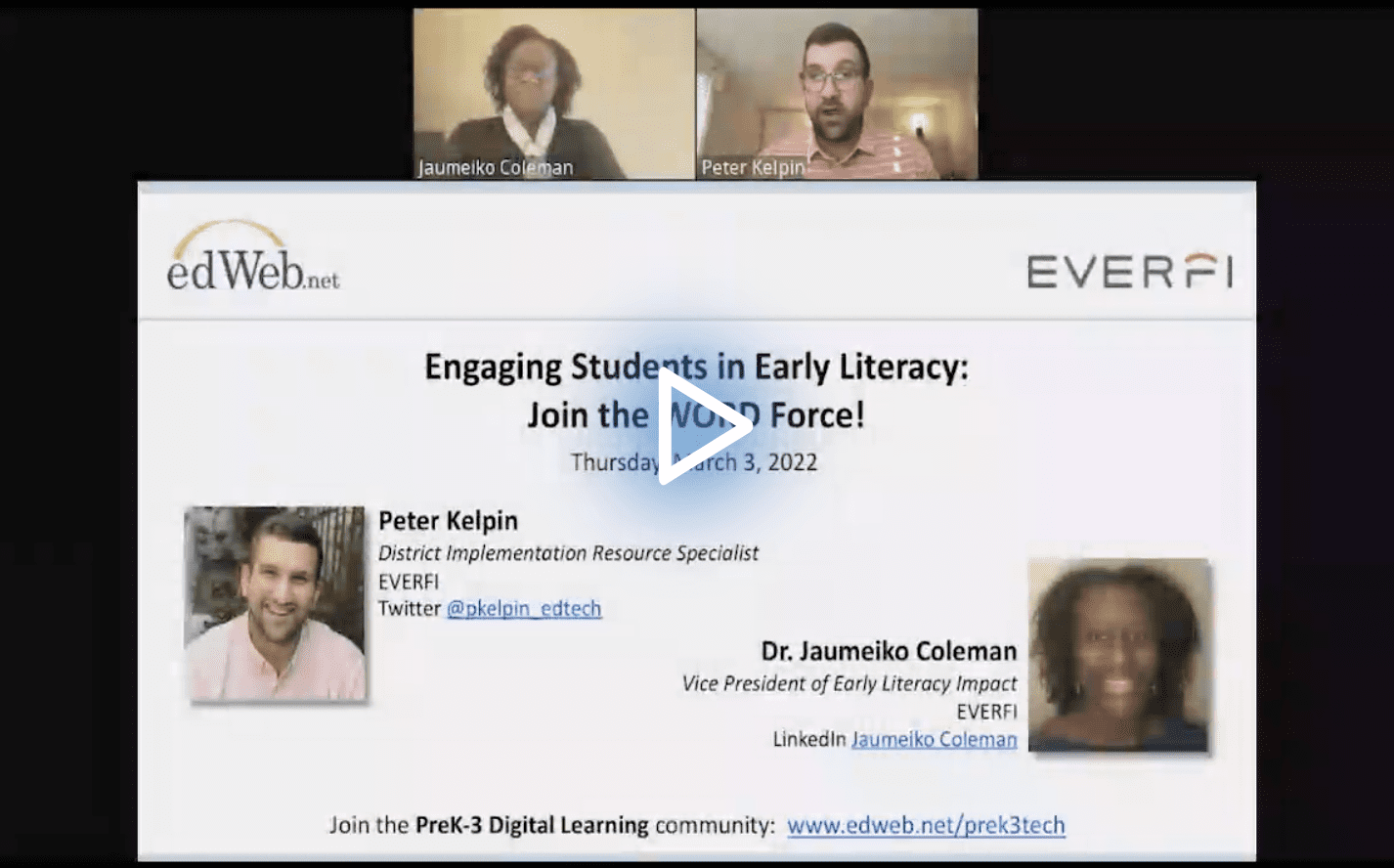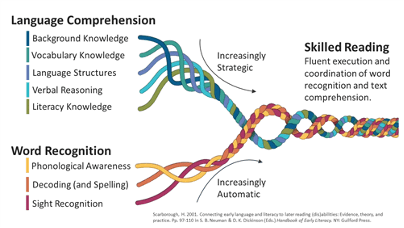The Science of Reading and Early Childhood Literacy
For decades educators have known that children who can read on grade level by the third grade stand a much better chance of succeeding in school and in life. The fundamental skills needed to read begin in early childhood and require the developmental scaffolding of skills to put all the pieces together for a child to become a proficient reader.
In the edLeader Panel, “Engaging Students in Early Literacy: Join the WORD Force!” Dr. Jaumeiko Coleman, Vice President of Early Literacy Impact at EVERFI, explains the Science of Reading and the critical role it plays in the early stages of brain development as children build the developmental skills necessary to connect spoken language to an alphabet to develop reading and writing skills.
What is the Science of Reading?
While there is some debate over the exact definition of the Science of Reading, Dr. Coleman says that a generally agreed-upon definition is, “the accumulated knowledge about reading, reading development, and best practices for reading instruction obtained by the use of the scientific method.”
Even though this sounds very academic, the truth is that reading development begins earlier than we can even imagine, as it begins “in utero” when a baby first hears its mother’s voice. The mother’s voice primes a baby’s brain to learn (or communicate).
However, this verbal communication is very different from learning to read. Over time, our brains evolve by using what is learned in spoken language to read and write. Scaffolding takes place to help our brains learn the alphabetic principles needed to map sounds onto letters to ultimately form words and sentences.
Language and Reading Development
Language is the foundational block of reading development, and it has four parts:
- Spoken Language – listening and speaking (oral language)
- Literacy – reading and writing (written language)
- Early Literacy – phonological awareness, early phonics skills, emergent spelling, print awareness, and spoken language
- Conventional literacy – phonics, reading vocabulary, reading fluency, reading comprehension, spelling, and writing
Putting these skills together can be complicated and identifying gaps in a child’s development can be challenging. For instance, Dr. Coleman says, “Children who have a hard time with listening comprehension often have a hard time with reading comprehension. The same goes for speaking and writing—when you’re speaking, you’re expressing yourself, and that’s in an oral fashion. When you write, you’re expressing yourself in written fashion.” The two are cognates and are related to one another.
Therefore, she continues, “If a child has a hard time speaking, they may have a hard time writing down those same thoughts on paper. So, when a child is struggling with reading and writing, we have to ask, ‘Is there something that needs to be done in the listening and speaking realm that might help them to facilitate their reading and writing acquisition?’”
For the focus of the edLeader Panel—early childhood literacy—there are critical skills that serve as the foundational building blocks to becoming literate. Phonological awareness is the central component of early literacy success. Simply defined, phonological awareness is an individual’s ability to manipulate the speech sounds found in spoken language.
Dr. Coleman explains that phonological skills involve the ability to make distinctions between words that have slight variations, e.g., “cat” and “hat”—with that slight difference, there is a distinction between a small, furry animal and something one wears on their head. The other early literacy skills include:
- Phonics: letter-sound associations
- Emergent spelling: putting the sounds in phonics in the proper order to form words
- Print Awareness: the proper way to turn a book for reading, proper direction for reading, understanding components of a book, etc.
Another important distinction to make in early childhood literacy is the difference between phonological awareness and phonemic awareness. Dr. Coleman explains, “Phonological awareness is the umbrella term that includes syllable awareness, rhyme awareness, and phonemic awareness, so phonemic and phonological awareness are not mutually exclusive.”
She further states, “Phonemic awareness is the most advanced phonological awareness skill that a child can have and in fact, that’s where we want them to land in the midst of learning how to put sounds together that are connected to letters written on paper.”
A strong foundation in early literacy prepares children for conventional literacy, which is when they learn to spell, decode words, and develop comprehension skills.
Scarborough’s Reading Rope
A leading researcher of early language development and its connection to literacy, Dr. Hollis Scarborough was a senior scientist at Haskins Laboratories and in 2001, she developed and published what has become known as Scarborough’s Reading Rope. It provides an excellent visual of how the Science of Reading works.
This visualization shows how the information is processed by the brain to develop the skills needed to put all the pieces of the literacy development puzzle together.
EVERFI, WORD Force, and the Science of Reading
To help put the pieces of the puzzle together, EVERFI, created WORD Force, a game-based digital program for K-2 students, which is available to all schools, districts, and families across North America at no cost.
Utilizing the elements in the Science of Reading, WORD Force takes all the components necessary to teach early literacy and wraps them into a fun, interactive, engaging game for young learners. Teachers, parents, tutors—anyone who helps young learners develop literacy skills, can use WORD Force to reinforce the instruction children are already receiving.
WORD Force integrates phonological awareness, word building, vocabulary, and reading comprehension. The games within the program are structured around a particular topic, and learners advance as they move along a continuum. After mastering 80% of a level in the game, students can move to the next level. The games use positive reinforcement to help children master the necessary skills to move up.
WORD Force is aligned to the Common Core State Standards, ELA K-2 Standards, and North Carolina’s English Language Arts Standard Course of Study. The five-game sets in WORD Force scaffold along a continuum to reach reading comprehension:
- Game Set 1: Phonological awareness and letter sounds/letter recognition
- Game Set 2: Advanced phonemic awareness and beginning reading with phonetically predictable CVC words and word families
- Game Set 3: Vocabulary, site words, and advanced spelling
- Game Set 4: Advanced vowel sounds and beginning comprehension with a focus on identifying the appropriate inflectional endings to build sentences that make sense and are grammatically accurate
- Game Set 5: Reading comprehension
Beautifully designed and highly interactive, the games spark creativity and are engaging for young learners. With themes like Sprouting Sounds, Veggie Village, and Wandering Words, kids stay focused to achieve the goals set forth in each game as they build their way to reading proficiency.

Even though the program is designed for grades K-2, EVERFI has received reports from schools and parents that children spanning grades PreK-5 have successfully used the program to build their early literacy skills.
Administrators, teachers, parents, tutors, or anyone interested in helping young children master the skills necessary to become proficient readers are invited to visit EVERFI to learn more about the free WORD Force program.
Learn more about this edWeb broadcast, “Engaging Students in Early Literacy: Join the WORD Force!” sponsored by EVERFI.
Join the Community
PreK-3 Digital Learning is a free professional learning community that hosts edWebinars, ignites edtech talks, and promotes wide-ranging discussions on using digital tools to support PreK through grade three classrooms.
From grade school through retirement, EVERFI’s free digital education curriculums empower learners of all ages to make safe, smart, and informed decisions. We bring together the public and private sectors so K-12 teachers can equip today’s learners with the skills they need to become tomorrow’s leaders.
Blog post by Ginny Kirkland, based on this edLeader Panel







Comments are closed.